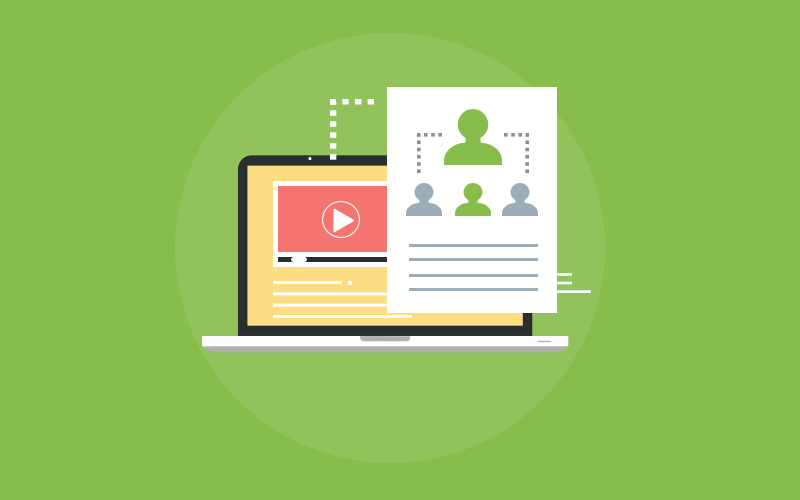
Employee onboarding is far more important than most people think. It’s not a mere formality done to comply with corporate customs.
Mitch Gray, the author of How to Hire and Keep Great People, says, “the ‘purpose’ element of onboarding is where you begin to lay the foundation of success for your new team member.”
As rightly pointed out, onboarding plays a crucial role in employees deciding whether to stay with a company or not and whether they remain committed to the organization.
Therefore, organizations need to have a robust employee onboarding process so that new hires can adjust to the new environment and become productive members quickly.
In fact, the statistics below also indicate the same.
- Companies with a strong onboarding process can improve new hire retention by 82%
- 29% of new hires feel that they are prepared for the job role after a good onboarding experience
- Addressing professional development during the onboarding process increases employee satisfaction by 3.5 times
- 70% of new employees who had a great onboarding experience believe that they have the ‘best possible job.’
Source: Brandon Hall Group
So, it’s clear that every organization needs to have a robust onboarding strategy. To help you understand the challenges and the nuances of onboarding people the right way, this post will walk you through the process of onboarding and some of the strategies & tools that can help you make the most of it.
What Is Employee Onboarding?
Employee onboarding is broadly defined as the process of familiarizing new hires with organizational policies, their role in the organization, and the corporate culture. It also includes creating a conducive environment where employees can interact freely with their colleagues and establish professional relationships in the workplace.
In particular, this includes employees filling out all the documents as required by labor legislation and providing them with all the necessary tools to perform their job well.
During an employee onboarding program, employees learn about the expectations from them regarding skills, communication style, and attitudes toward work.
Watch: How to Create an Employee Onboarding Training Program
The success of onboarding new employees depends on the effectiveness of the onboarding program. The sooner employees can do their jobs, the faster they will become valuable members of an organization.
Onboarding is not just an HR task.
It’s also the responsibility of the line manager to educate employees about their role in the company, their expectations from them, and the corporate culture.
Apart from making employees familiar with their job roles, there’s a lot of paperwork involved. This is where HR software can help. It helps you view the entire process on the system while also helping you track it end to end from a centralized place.
Keep in mind that an employee onboarding process isn’t just about new hires.
When existing employees move into new positions, for example, to fill in vacant posts, they also need to go through adaptation (known as rotation or cross-boarding; discussed later in this article).
Even though existing employees are already familiar with the corporate culture, the new team’s culture may differ slightly. While they may be familiar with job functions, they may still need a mentor to introduce themselves to their new role.
Here’s a quick guide on how you can build the perfect employee onboarding process.
Why Does Efficient Employee Onboarding Matter?
An efficient employee onboarding plan is significant for both employees and the organization. Let’s understand how companies and employees can benefit from a good onboarding process.
Benefits for Employees
- Getting up-to-date information. An employee does not have to run around the office looking for answers, distracting colleagues from work.
- Reducing uncertainty and stress levels. According to psychologists, job change is in third place in terms of stress level (after the death of a loved one and divorce). The idea is to support a new hire during this period.
- Mastering the norms of corporate culture and rules of conduct.
- Receiving feedback from a mentor or leader, that is, understanding your “growth zone.”
- Professional development
- Increased job satisfaction
- Building relationships in the team
- Quick infusion into the workflow
- Acquisition of new skills and knowledge
- Comparison of the expected performance with employees’ actual activities
- Reduced fear of being fired during the probationary period
Benefits for a Company
- Decrease in staff turnover and, as a result, the formation of a favorable HR brand
- A mechanism for evaluating the work of an employee based on the results of the first few months
- Planning an employee’s career
- Increasing employee loyalty to the company
- Formation of a personnel reserve of managers (mentors)
- Increased workforce efficiency and accelerated productivity level
- Establishing and maintaining positive relationships
- Prevention of costly mistakes that new employees could make
- Reducing the time spent by experienced workers to assist a new employee in the process of performing their job duties
4 Stages of the New Hire Onboarding Process
The onboarding process for new hires can take place in four main stages:
Stage 1: Assessment of the Level of Preparedness of New Employees
This assessment is necessary to develop an effective adaptation program. Even if an employee has special training and work experience in similar structures, getting into a new organization will present a different external environment, new personnel, and technology.
Stage 2: Orientation on the Spot
This includes practical acquaintance of the employees with their duties and the requirements they must deliver. The direct supervisor and the personnel management service are involved in this onboarding phase.
Stage 3: Direct Adaptation
This stage transforms new employees into their professional status and is determined mainly by their inclusion in interpersonal relationships with colleagues. This element of adaptation is vital, as it affects how new employees will be accepted in the new workplace.
It’s essential, at this stage, to provide maximum psychological support to the employees, conduct regular conversations, and evaluate the effectiveness of their activities in the new workplace.
Stage 4: Full Involvement in Work
This stage of the employee onboarding process completes the adaptation process of a new employee in the organization. It’s characterized by gradually overcoming production and personal problems and transitioning to stable work.
Suppose the adaptation process in the organization is well-regulated. In that case, the adaptation period and associated costs are greatly reduced and bring significant benefits to both the organization and the employees.
5 Employee Onboarding Steps to Follow
A structured onboarding process can be broken down into several steps, starting with signing a contract by the new employees and ending with a long-term commitment.
Here’s how it goes:
Step 1: Preparation
There’s often a time between signing the contract and the start date that employers can ideally use to prepare for onboarding. The essential steps are:
- Setting up the workplace. What equipment do the new employees need (desk, preconfigured PC, telephone, keys, business cards, name badges, passwords, etc.)
- Who will take care of the deployment?
Step 2: Sharing Details of Contact Persons
It’s always possible that future employees still have questions. Therefore, a list of contact persons with telephone numbers, email addresses, or business cards is helpful.
Step 3: Information Gathering
Even if new employees have already informed themselves about the company, its products/services, and its culture, they will undoubtedly be grateful to have the information available on demand.
An information folder usually contains:
- a company manual
- brochures
- further education and training catalogs
- an organizational chart, or a list of access data (email password, access to e-learning platforms, etc.)
Creative approaches to educate new hires on their new workplace include quizzes about the company, which ask about important facts playfully. Using such gamification elements in recruiting engages and motivates employees to learn.
Having a training course with step-by-step chapters to explain important aspects of their role with a well-defined learning path also helps in bringing the much-needed clarity.
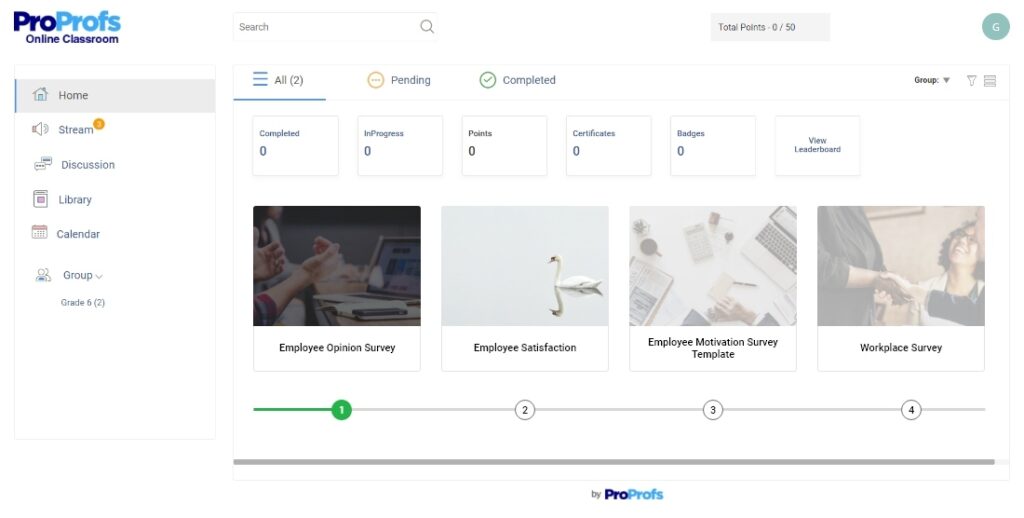
Step 4: Informing the Work Colleagues
You should inform the existing employees in advance about their incoming counterparts. Share a short description with interesting details about the new hires with the exact entry date and, if necessary, a profile photo on the intranet or by email.

Step 5: Assigning a Buddy/Sponsor
It makes sense to provide the new employees with a sponsor. These sponsors would be responsible for the new hires’ learning and other activities. It can be helpful to select an employee with a similar area of responsibility who introduces the future colleague to their place of work and answers any queries they may have.
Top Recommendations For Successful Employee Onboarding
Below are some recommended practices you can follow to improve your onboarding process.
Make the Tasks Clear for Your New Hires
In practice, adaptation is always a reciprocal process: the employer sees if a new employee suits them, and employees assess their manager and decide about their tenure in the organization.
The employer must do the following:
- Work out the adaptation plan for new employees
- Clearly define the tasks, deadlines, and intermediate checkpoints
- Make the newcomers’ functions clear
This way, it’ll become easier for new employees to understand their organizational roles and responsibilities.
Discuss All the Pitfalls With Your New Employees
For example, you can often observe the following practice: when new employees go to work, they are “stuck” with responsibilities for two positions at once.
Such practice is more common in small businesses due to a lack of manpower and the absence of a proper hiring process.
This leads to:
- the disappointment of the new employees
- a mismatch of their expectations with reality, and as a result, leaving the company during the probationary period.
Solution: At the interview stage with the candidate, discuss everything about their exact roles and responsibilities and reiterate this during onboarding process.
Watch: Hiring & Interviewing
Understand the Goals of Adaptation
One of the purposes of adaptation is to assimilate new hires into an organization in the best possible way while reducing the organization’s costs.
Factors that can reduce an organization’s costs are:
- Fast induction. This means that the new employee is expected to reach the level of productivity required of them soon. Here, a standard onboarding platform can make all the difference.
- Reducing the number of errors due to effective training of new employees.
- Reducing the level of staff turnover as a result of the implementation of effective adaptation methods.
- Understand the Benefits of Adaptation
Having a new employee onboarding plan brings benefits to a company as well as an employee. Examples include compliance with company policies, clarity of job roles and company goals, and improved employee satisfaction and performance.
Click here to learn about the best employee onboarding plans and practices.
Personnel Onboarding Methods and Tools
Companies that understand that a strong workforce is key to success (and profit!) are developing systems to accommodate new hires efficiently and effectively. These systems include activities carried out by employees, and they are designed to build two types of motivation:
- External, that is, economic
- Internal or personal
With economic motivation, everything is more or less obvious. Financial rewards should correspond to the level of a specialist, and bonuses only strengthen loyalty. This is understandable.
But what is “personal motivation”?
Intrinsic or intangible motivation is closely related to corporate culture. This is an employee’s desire for personal growth and development within the framework of a given company.
For such motivation to arise, it is necessary to carry out several activities that help new employees get involved in the company’s life.
There are several employee training methods, strategies, and tools to meet this need:
Conducting Training and Workshops for New Employees
New employees will quickly join the workforce if you systematically train them on how everything works. This is especially needed when they cannot figure things out on their own by trial and error.
Here, employee onboarding software will prove immensely helpful. Using these employee onboarding tools, you can:
- easily create employee onboarding training courses and tests
- share them with your new hires
- track progress in real-time
- view insightful reports & analytics
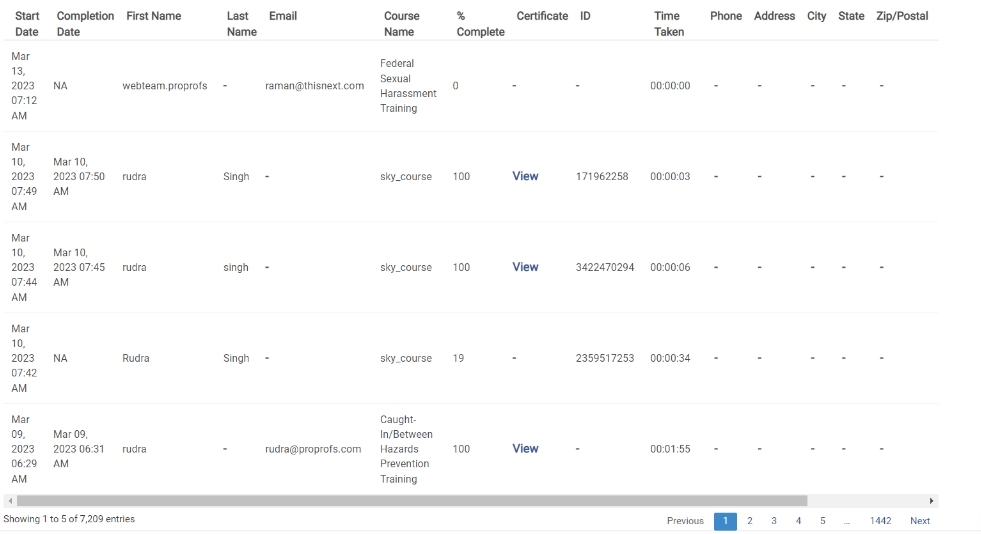
The case study discussed below will help you understand the benefits of using onboarding software.
DigitalOcean, a US-based company, found it difficult to manage its onboarding process. Its existing onboarding process remained burdensome. Limited connectivity, paper-based checklists, etc., became a challenge for them.
That’s when the organization decided to use onboarding software to streamline the entire process.
The company onboarded nearly 70 employees in just six months. Plus, the new hires appreciated how the software helped them understand what they should do in the upcoming weeks.
This way, the company simplified and streamlined its onboarding process. The solution yielded better results while at the same time it gave an enjoyable experience to its new hires.
You can also go for such a solution. For example ProProfs offers a full-fledged LMS to cater to such needs:
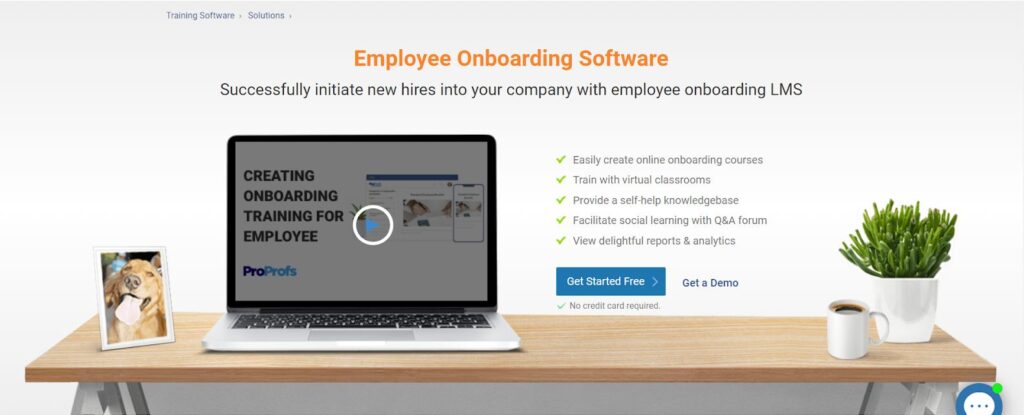
Moving on, if you’re looking for ready-to-use onboarding courses and training templates, here are a few suggestions:
Code of Conduct Training
The code of conduct training will help your employees learn the principles and expected behaviors that guide your organization. Train your employees about right and wrong conduct and help them understand how to apply the code of conduct to business operations.
Watch: Understanding the Code of Conduct | Training Course Introduction
Diversity & Sensitivity
A workplace is full of people from different backgrounds and cultures. Therefore, an onboarding process for new employees must have a training program based on diversity and inclusion.
Watch: What Is Diversity, Equity & Inclusion? | Training Course Introduction
This will help them learn how to mix with different people and respect others’ opinions.
Security Awareness Training
Ensure a safe work environment through security awareness training. This training is important for the successful onboarding of new employees. Security awareness training will include formal education on security and privacy issues related to device usage, passwords, data leakage, social engineering, and phishing.
Watch: What Is Security Awareness Training for Employees? | Course Introduction
Interpersonal Skills
These skills are extremely important for both managers and employees.
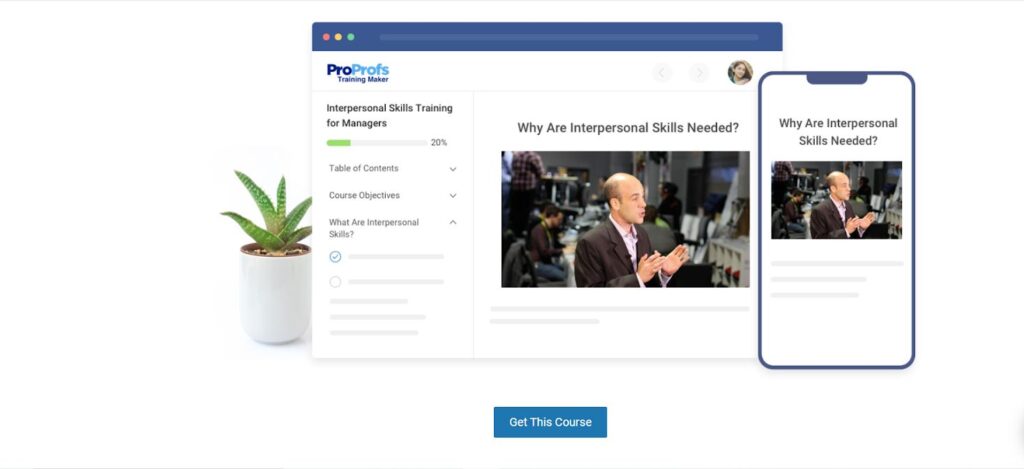
This training will help them learn the best communication skills and make them great problem-solvers and active listeners.
Facilitating Communication Between the Manager and Employees
It’s essential to monitor how the immediate supervisor communicates with a newcomer. Employers should not leave employees in the dark about how the employees should manage their duties. But communication should work in the opposite direction too.
A new employee should ask questions to the manager and treat feedback & comments professionally. Communication training is essential for new employees’ onboarding process.
Watch: How to Develop Effective Communication Skills for Managers | Introduction
Providing Group Assignments for Better Teamwork
Whatever the job specifics might be, new employees must get to know their colleagues, establish informal connections, and join forces. If you let the process take its own course, beginners can limit themselves to only a narrow circle.
Organizing Team-Building Activities
Team-building events and discussion forums allow employees to get to know each other better and provide everyone, including new employees, with a comfortable environment.
Watch: How to Build High-Performing Teams | Training Course Introduction
Maintaining Corporate PR
It’s no less important than external PR. Employees, like customers, must understand the values and aspirations of the company, and the company needs to shape its image as a reliable employer.
Providing a Single Source of Information for Employees
Everyone should understand what’s happening in the company, represent it fully, know about its achievements, and quickly obtain information about colleagues and find their contacts. Corporate social networks and knowledge base can be useful here.
That was all about the employee onboarding steps you must follow. Let’s now discuss some interesting tips and tricks to build a solid onboarding process for your new hires.
Best Practices for Effective Onboarding Process
The first basic idea is to be there for your new hires. It doesn’t matter how cool your company is and how much you pay.
If you want an employee to pass the probationary period, then you need to be in touch with them constantly. You can leverage chats, private messages, conversations, and calls.
The employee onboarding checklist below can supplement and help implement this basic rule.
Create a List of Mini-Tasks That a Beginner Should Complete in the First Week/Month
For example, if they are working on content marketing, perhaps a mini-task would be to find their favorite piece of published content and analyze why it works well.
Mentor
It’s good if the new employee gets somebody who can act as a mentor to understand their needs. There must be a partnership, not competition.
Provide an Easy Employee Handbook
You can incorporate it into a Notion template or workspace to keep things fun. This can be in the form of a playbook or access to a well-designed knowledge base that has answers to their queries.
Make a Post on the Corporate Network
Make it available on Instagram, LinkedIn or add it to the general chat of the company. You can even get an LMS with a collaboration platform that helps share this information.
Organize a Team Party
That’s where you can introduce the new hires to their colleagues in an informal setting. If a physical party isn’t possible for remote employees, have a zoom party instead!
Give the New Hires a New Workspace, a New Computer, and a Phone
It’s nice for the employee to know that they didn’t borrow someone else’s stuff.
Share a List of Difficulties That New Employees Face
Also share the hacks to get over such common problems. This will make employees less apprehensive about opening up.
Discuss Prospects for Career Growth
It’s best to do this during the interview, but if there’s not much possibility in terms of growth, explain how the role will grow over the next 3, 6, 12 months and beyond. Also explain the expectations from them during this period.
Make the Best of Your Employee Onboarding Process
After reading this blog, you should be able to follow the best onboarding process for employees. However, keep in mind that onboarding cannot be seen just as a process of learning a new job. It involves immersing an employee in a new environment, understanding the rules of behavior and teamwork, accepting corporate norms, and establishing relationships with colleagues and partners.
The onboarding process for new hires can go in different ways: somewhere, a newcomer is thrown into the thick of things, hoping that they will figure it out themselves; somewhere, they are treated with care so that the stress experienced by the employee is minimal.
It’s essential to understand that the adaptation duration does not necessarily coincide with the course of the probationary period; it can take up to four months or more. A well-developed adaptation plan, mentoring, and training system will help speed it up.
Do you want a free Training Software?
We have the #1 Online Training Software for employee training & assessment




